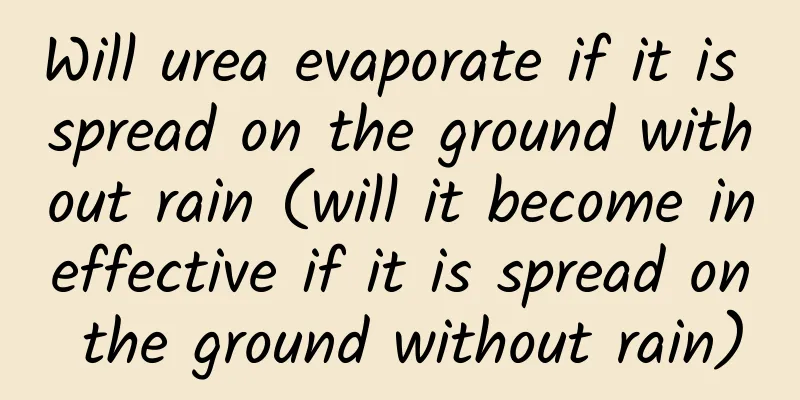Will urea evaporate if it is spread on the ground without rain (will it become ineffective if it is spread on the ground without rain)

|
Urea is a fast-acting high-nitrogen fertilizer that we often use. Most of the time, it is used as topdressing, and it is best to cover the soil. However, nowadays, topdressing methods are mostly broadcasting, such as applying urea to corn and wheat. It is based on broadcasting on the ground before or after rain, and when watering. Few people use the method of fertilizing by marking or digging holes. Spreading urea on the ground will cause nitrogen loss regardless of whether the soil is moist or not, and the utilization rate will be greatly reduced. Urea is an amide nitrogen fertilizer. Although it can be directly absorbed by crops, the amount is not large. It needs to be converted into ammonium carbonate, which then needs to be further decomposed into ammonia, carbon dioxide and water before it can be absorbed in large quantities by crops. Urea will cause nitrogen loss during this decomposition and conversion process, and the faster it decomposes, the greater the loss . The speed of urea decomposition and conversion process is mainly related to these factors. First, temperatureThe conversion rate of urea in the soil is faster when the temperature is high than when the temperature is low. When we spread it on the surface, the ground temperature will be higher than the underground temperature due to sunlight, which will cause the urea to decompose faster and the corresponding loss will increase. Second, soil Urea decomposes faster in dry land than in paddy fields, faster in clay soil than in sandy soil, and faster in neutral and calcareous soil than in acidic soil, so the surface loss will increase when spreading. Especially in alkaline soil, the ammonia volatilization loss will be greater when spreading. Third, other When urea is mixed with organic fertilizer, it will be lost faster than when it is not used in combination with organic fertilizer, so the loss is also greater. Some people may wonder, if urea and organic fertilizers together cause large losses, why is it said that it can enhance the effect when mixed with organic fertilizers? Isn't this a contradiction? I said that applying urea with organic fertilizer will speed up the decomposition rate, but also increase the loss rate, which is based on broadcasting. If we cover urea with organic fertilizer, or apply it as base fertilizer after mixing, in the case of burying in the soil, although the decomposition rate is accelerated, the conversion rate is also accelerated, the utilization rate of fertilizer will be improved, and the loss will be reduced. Based on the above, whether the surface has rained lightly or heavily, or is dry, spreading urea on the surface will cause ammonia volatilization loss, but the volatilization rate varies. To improve the utilization rate of urea, pay attention to the following points.First, try to use it alone The ideal application method is to apply organic fertilizer first, and then reasonably apply various fertilizers such as urea and potash fertilizer. It cannot be mixed with alkaline fertilizers such as ammonium bicarbonate, wood ash, calcium magnesium phosphate fertilizer, etc. Second, it is not suitable to spread on the surface. When urea is spread on the ground, it takes 4-5 days of conversion at room temperature before it can be absorbed by crops. Most of the nitrogen is volatilized during this conversion process, the utilization rate is greatly reduced, and it is easy to cause fertilizer damage to crops . One year, a man sprinkled urea in the fruit tree tray and then hoeed it to mix the urea with the soil. But unexpectedly, after a few days, the leaves at the bottom of the fruit trees turned yellow and fell off in large numbers. This was because the volatilization of ammonia caused ammonia poisoning of the leaves. Third, do not water immediately after applying urea. Urea will dissolve into small organic molecules after application, which are not easily adsorbed by soil, have strong mobility and are easily lost with water. If urea is applied immediately after watering or applied to dry land before heavy rain, urea will be lost immediately. Generally, it is best to water the plants 3-5 days after applying urea in summer and 8 days in winter. In short, surface application of urea is indeed not very good, but it has become a popular method of fertilization now. It is just spread and gone. Although the utilization rate is low, it cannot withstand frequent application. It saves labor and effort but not money, especially now that urea is so expensive, it is indeed a bit of a waste. However, the loss in the body can be made up outside, and the time saved by working outside can also make up for it. How do you apply urea in the market? Is it also applied by broadcasting? |
Recommend
How to prepare succulent nutrient solution
1. Rice washing water The method of making nutrie...
How often should I water the fiddle-leaf fig?
How often should I water the fiddle-leaf fig? The...
Orchid cultivation methods and precautions
1. Soil Generally, we choose humus-rich, loose an...
What are the flowers that are evergreen and cold-resistant?
1. Cold-resistant flower varieties: 1. Vinca When...
How often should potted plants be watered? How often should potted plants be watered?
How often should potted plants be watered? When w...
How to grow rainbow succulents
1. Soil The succulent rainbow plant has strong vi...
How to divide the miniature coconut
Time for dividing the miniature coconut The types...
How to grow lucky bamboo to make it bloom, what does blooming mean
1. Maintenance methods to promote flowering Under...
Should I use a large or small pot for peony?
Should I use a large or small pot for celery peon...
Does the Heat Sambac bougainvillea bloom frequently and grow quickly?
The reason why the word "hot" is includ...
The difference between the fortune tree and the money tree
1. Different families The scientific name of the ...
The growing environment and local conditions of pitaya
Dragon fruit growth environment and conditions Dr...
Can loquat seeds be planted?
Can loquat seeds be planted? Loquat seeds can be ...
What vegetables to plant in spring
1. Cabbage Cabbage is a herbaceous plant of the g...
The difference between flower allium and rain orchid
Family Flower allium belongs to the genus Allium ...









